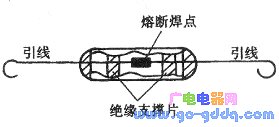Thermal fuses, often referred to as temperature fuses, were first developed in the 1960s in the United States. Originally designed to prevent overheating in fuel injection pump motors of jet engines, these components are now widely used in various household appliances such as electric kettles, rice cookers, and heaters. When a device exceeds its safe operating temperature, a thermal fuse automatically cuts off the power supply, helping to prevent potential fires caused by overheating.
The typical structure of a thermal fuse is illustrated below.

Thermal fuses operate based on a specific melting point, typically determined by a thin metal sheet. The composition of the melting alloy can be adjusted to set different melting temperatures. This makes them ideal for applications where precise temperature control is essential.
Modern thermal fuses have a relatively simple design, with the fuse element being a solder joint between two lead wires, as shown in the image below.

There are three key parameters that define a thermal fuse:
- Operating Temperature: This refers to the temperature at which the fuse will melt and cut off the circuit.
- Tolerance: Due to variations in manufacturing processes and material compositions, each thermal fuse may have a slight difference in its melting point. This variation is known as tolerance, usually ranging from 1.6°C to 1.85°C.
- Rated Current and Voltage: Every conductor has internal resistance, which generates heat when current flows through it. If the heat becomes too high, the fuse will activate. Therefore, thermal fuses are rated for both current and voltage to ensure safe operation under normal conditions.
Understanding these characteristics helps in selecting the right thermal fuse for specific applications, ensuring both safety and reliability in electronic and electrical systems.
FRP/GRP Trench Cover,GRP Trench Cover,fiberglass trench covers,grp trench
Hebei Dingshengda Composite Material Co., Ltd. , https://www.frpdsd.com